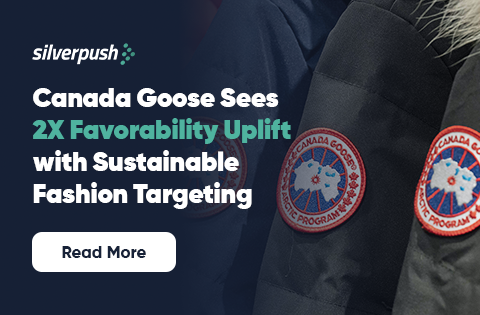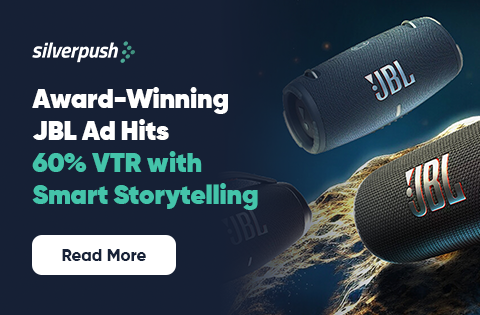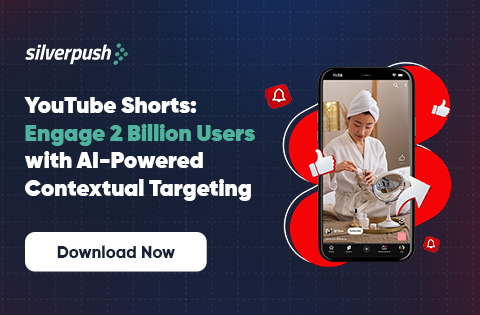Lights, Camera, Insights! How Advertisers can Win the Oscars
PUBLISH DATE: 11 March 2024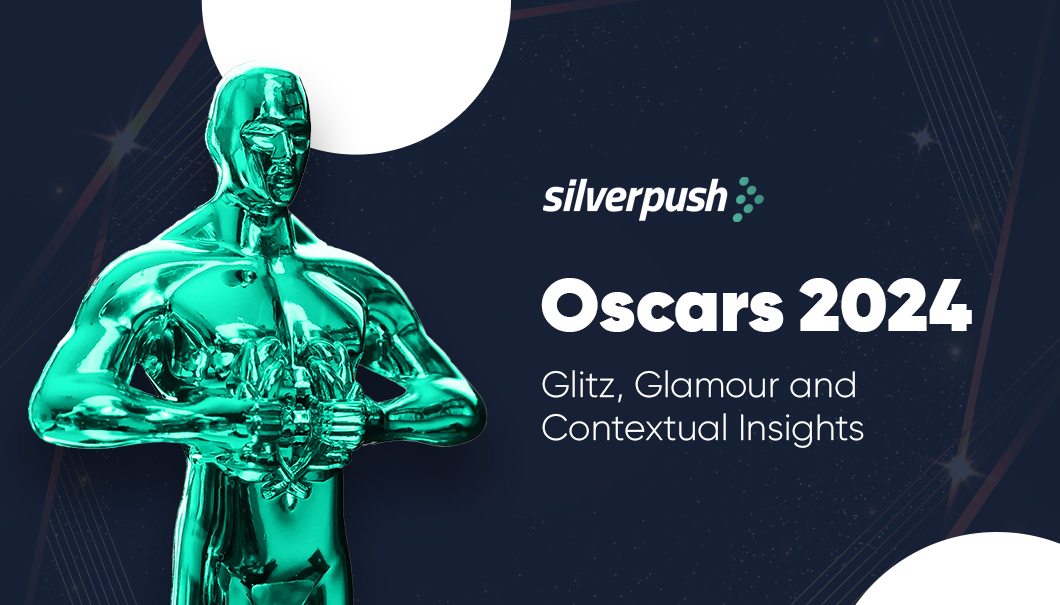
As the Oscars draw near this week, let’s delve into the captivating world behind the glamor and glitz!
🎬 Exploring pivotal categories and emerging interests, our Contextual Insights provide an exclusive peek into the secrets of success on Hollywood’s grandest stage. Hosted by Jimmy Kimmel, the 96th Academy Awards are igniting substantial online excitement. Go beyond the surface glitter and uncover the pulse of audience interests and trending topics.
In the dynamic landscape of today’s world, seasonal events unfold with remarkable frequency. It’s this keen understanding of these occasions that empowers Silverpush and its partners to seize the opportunities they present. Our analysis focuses on the upcoming Red Carpet Season, delving into its potential impact on Video Advertising. By shedding light on the evolution of content creation and consumption, we aim to provide valuable insights into how the Awards and Festival period from last year has influenced the current year thus far.
It isn’t over when the curtain falls – After the awards, the Oscars live on—on YouTube
The Oscars may end when the curtain falls, but the excitement lives on long after the last trophy is handed out. While celebrities flock to after-parties, audiences turn to YouTube, where the celebration continues. Surprisingly, there are more searches for the Oscars the day after the event than on the day itself, both on YouTube and Google Search. As people return to work, they catch up on the highlights and controversies, eager to engage in watercooler conversations, with video being their preferred medium.
How Can Brands Win on Awards Night and Beyond with Contextual Advertising?
Brands have a unique opportunity to seize the spotlight during awards season, extending their reach far beyond the confines of the red carpet. While viewers tune in to iconic moments, speeches, and high-fashion statements, they also eagerly anticipate the commercials, with a remarkable 90% of Disney viewers expressing favorability towards advertisements during the Oscars.
Contextual targeting offers advertisers a powerful tool to strategically place their ads in front of audiences immersed in Oscars-related content. By understanding the context in which users are consuming content—whether it’s watching videos about nominees, red carpet coverage, or engaging in post-show discussions—advertisers can tailor their messaging to align seamlessly with the viewer’s interests and mindset.
This approach ensures that ads are not only relevant but also timely, capitalizing on the heightened attention and anticipation surrounding the event. Be it promoting fashion brands alongside red carpet coverage, showcasing luxury products during commercial breaks, or aligning with the themes of nominated films, contextual targeting enables advertisers to effectively engage with audiences in a way that feels natural and non-intrusive
Moreover, contextual targeting allows advertisers to reach users across various platforms and devices, ensuring a cohesive and integrated advertising experience.
By harnessing the power of contextual advertising, brands can not only capture the attention of audiences during awards season but also drive meaningful connections that resonate long after the final curtain falls.
Trick or Treat? Reach Your Audience with Spooktacular Ad Campaigns!
PUBLISH DATE: 10 October 2023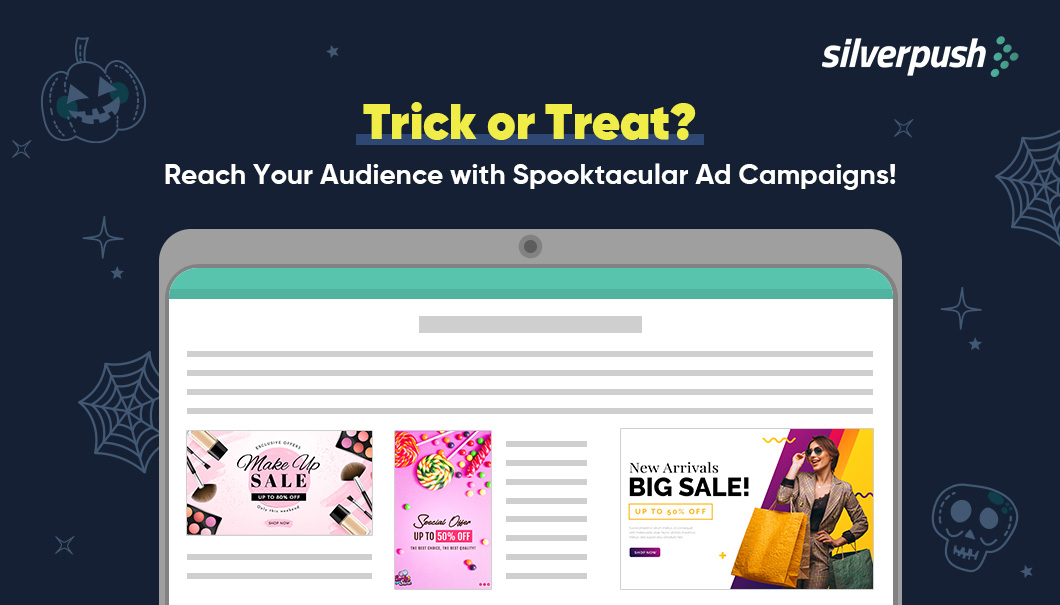
“A successful marketing campaign is like a well-carved pumpkin – it leaves a lasting impression.”
Every brand and advertiser aims to craft a compelling narrative that deeply connects with their audience, and leaves a lasting impression. Halloween season offers a unique opportunity to connect with your audience through spooktacular Halloween ad campaigns that capture the spirit of the holiday.
But before we delve into how to seize the opportunity let’s focus on….
Why Advertisers Should Ace Their Halloween Campaigns?
Halloween isn’t confined to any particular region anymore. It’s a global celebration, making it the perfect stage for brands to embrace cross-cultural marketing or launch multicultural campaigns. Did you know, in Japan, approximately 20-30 million people celebrate Halloween each year whereas, in the Philippines, 90% of people know and celebrate the spooky festival.
Moreover, Halloween spending is on a thrilling trajectory, set to hit a spine-tingling $12.2 billion this year, surpassing the 2022 figures by $1.6 billion.
Where the audience is spending the most?
The big bucks are flowing into candy (96%), decorations (77%), costumes (69%), and even greeting cards (35%). And where are folks flocking to get their Halloween fix?
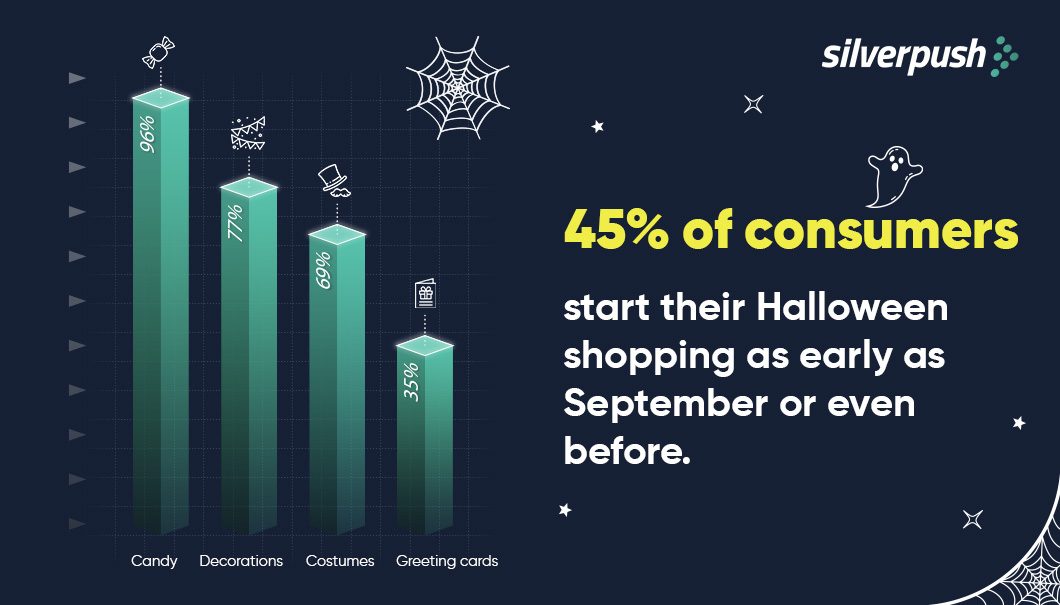 Candy (96%), Decorations (77%), Costumes (69%), and even Greeting cards (35%). 45% of consumers start their Halloween shopping as early as September or even before. Additionally, a significant 22% of consumers believe that retailers can begin showcasing and selling Halloween products.
Candy (96%), Decorations (77%), Costumes (69%), and even Greeting cards (35%). 45% of consumers start their Halloween shopping as early as September or even before. Additionally, a significant 22% of consumers believe that retailers can begin showcasing and selling Halloween products.
Halloween presents a lucrative chance for brands to engage with their audience extensively, as a substantial 45% of consumers start their Halloween shopping as early as September or even before. Additionally, a significant 22% of consumers believe that retailers can begin showcasing and selling Halloween products, both online and in physical stores, without any concerns about it being too early.
Well, the numbers speak volumes, but they don’t tell you how to reach your audience effectively. (But we do!)
How to Cast a Spell of Engagement This Halloween Season?
What humans see tends to linger in their memory, but the modern average user is constantly bombarded by ads throughout the day. In fact, they may encounter anywhere from 4,000 to 10,000 ads daily, yet only notice a fraction of them—less than a hundred, to be precise.
So, how can your message stand out in this advertising onslaught? The answer is surprisingly simple: harness the power of video ads and ensure they are contextually relevant to the moment.

Since we have gained the foundation understanding about the significance of video ads we must look into how to make these holiday season video ad campaigns effective.
1. Be Relevant
Approximately 79% of consumers are comfortable with ads that are relevant to the topics they are currently engaged with.
With the decline of third-party cookies, advertisers are shifting their focus to contextual targeting. This approach results in a 30% higher conversion rate compared to non-contextual ads.
Reaching the right audience at the right time not only fosters positive brand recognition but also boosts engagement.
2. Omnichannel Presence
Brands must follow the mantra of “Reach your audience where they are.” This means having an omnichannel presence to connect with audiences across various platforms where they leave their digital footprints.
An integrated brand presence across multiple marketing channels enhances brand awareness and facilitates easier audience connection.
Silverpush’s Mirrors offers a solution to reach the right audience on platforms like Open Web, Meta, and YouTube. It employs AI-driven context identification technology, ensuring precise audience targeting, even in a cookieless tracking environment.
The human-augmented technology offers contextual advertising across platforms while maintaining strict brand safety guidelines.
3. Dynamic Video Optimization
Today the attention span of the audience is similar to a toddler. But with dynamic interactive videos advertisers can engage the audience for a longer span of time.
Studies show that brands can increase consumer engagement up to 3X with 15-second interactive ads.
Crafters is a flagship product by Silverpush that harnesses real-time data and user insights to revolutionize ad campaigns.
Advertisers can deliver highly personalized and relevant ad experiences to their audience through precise targeting and endless customization opportunities.
Conclusion
Holiday season ads are best to captivate the audience but to achieve the goal advertisers must adopt the best option. With the demise of third-party cookies, contextual advertising has taken center stage. So to stand out front of the competition advertisers must opt for contextual targeting while adding the layer of interaction to make their ad campaign as spooktacular as their celebrations.
Navigating Path with Contextual Advertising in a Programmatic Advertising Landscape
PUBLISH DATE: 29 August 2023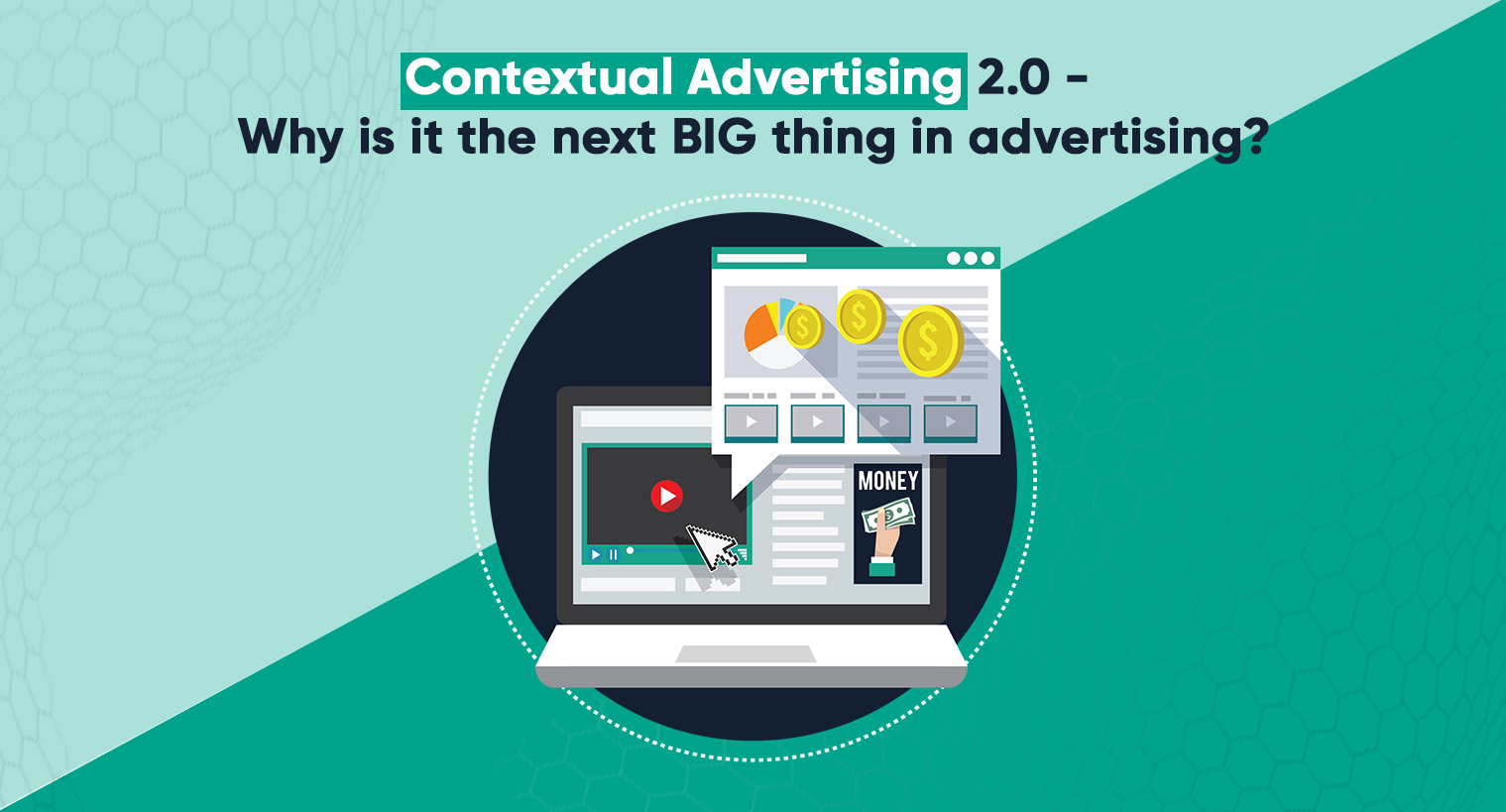
In the rapidly changing landscape, a seismic shift is underway. We are living in times when automation has taken center stage in all sectors, especially advertising.
Gone are the days of laborious manual toil for advertisers and publishers alike. Enter programmatic advertising, the game-changer that harnesses data and technology to plan the perfect sync of ads, reaching their intended audience at the precise moment.
The prediction of global programmatic ad spending is to reach 725 billion by 2026. The United States remains the leading programmatic advertising market worldwide. However, advertisers often encounter, two major challenges with programmatic ads:
- Lack of transparency
- Ineffective targeting
The programmatic advertising environment is intricate and opaque, making it challenging for advertisers to comprehend how the advertisements are deployed. As a result, advertisers waste money on ads and overpay. Programmatic advertising falls short of engaging the target audience since it heavily relies on data.
Also Read: What is Programmatic Advertising?
Navigating Path for Advertisers to Overcome Obstacles
Along with these challenges, there is another elephant in the room, the demise of third-party cookies.
With the third-party cookies phase-out, tracking user data will be difficult as they will not have a unique identifier that can be used to track users across multiple websites.
In this evolving landscape, advertisers find themselves at a crossroads.
- They are in desperate need of a solution that offers them a way to overcome the programmatic ad challenges.
- A solution that targets ads without interfering with the user’s privacy.
As a solution, contextual advertising is a ray of hope.
Contextual Advertising as a Solution: How?
In the dynamic realm of advertising, contextual advertising isn’t a newcomer. This methodology which aligns ads with the surrounding content, lost its spotlight as advertisers pivoted towards behavioral targeting, a strategy yielding superior outcomes by delivering personalized ads.
Yet, the relentless pursuit of personalization led to an overindulgence, raising concerns among users about data misuse and their digital safety.
The privacy concerns of users led to the introduction of strict guidelines by GDPR and CCPA along with major browsers banning the use of third-party cookies.
These changes have made advertisers retrace their steps to an older path of advertising– Contextual Advertising.
Contextual display advertising focuses on aligning the ad with the content of the web page rather than emphasizing the user’s data.
The AI-powered system identifies key contexts of the web page’s content and serves the most relevant advertisement based on contextual cues.
For example, a user engrossed in an article about car maintenance encounters an ad spotlighting the latest automobile release by a prominent brand. Here, the connection is made not through personal data but through content relevance.
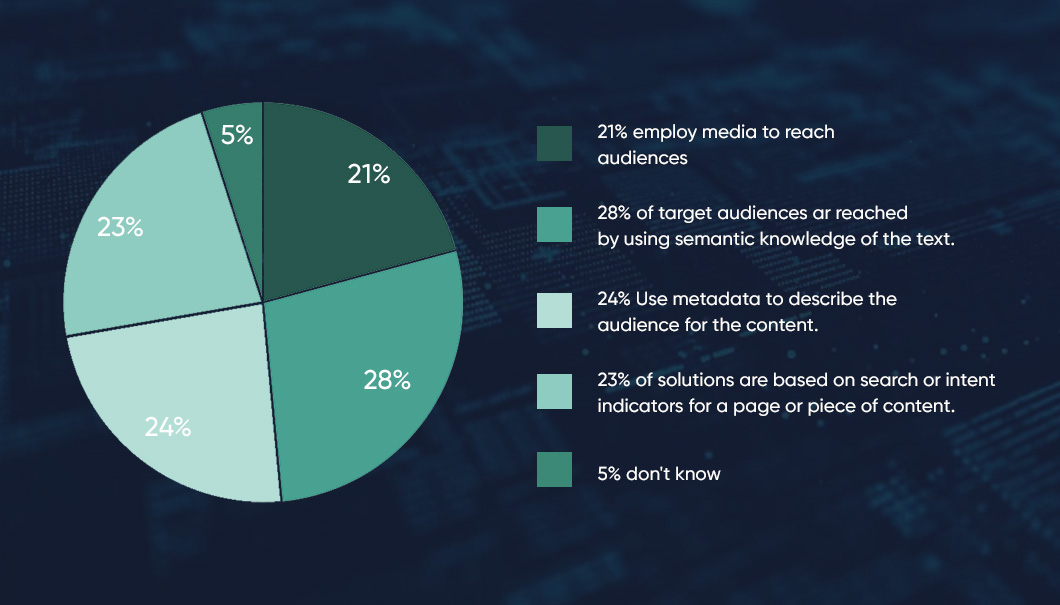
Contextual targeting 2.0: Why is it better this time around?
As the world moves forward, contextual advertising is pacing up with it! The recent advancements in algorithms have helped advertisers to perform hyper-contextual targeting.
Natural language processing (NLP) is used to analyze the text content of web pages in order to help advertisers understand the context of the content.
Machine learning is used to develop algorithms that can predict the likelihood of a user clicking on an ad. This can enhance the ROIs and ensure advertisers that they are only paying for ads that are likely to be clicked on.
Hyper-contextual targeting is still in its early stages, but it has the potential to revolutionize the way that advertising is targeted. As AI and ML continue to develop, hyper-contextual targeting is likely to become even more accurate and effective, leading to better results for advertisers and publishers alike.
Get Started with Contextual Advertising Today!
AdTech organizations are taking full leverage of this evolving time! Silverpush, a leading ad tech organization, has introduced Mirrors, an AI solution for programmatic contextual advertising.
Mirrors comprehensively identify key contexts across webpages, including text, images, and videos. Utilizing Natural Language Processing (NLP), it identifies keywords and categorizes content. Additionally, AI-powered technology employs video analysis for image recognition, effectively identifying celebritiy name, brand name, and various activities within images.
Furthermore, Mirrors employs semantic analysis on the content of a webpage. This enables the extraction of significant information, including emotions and instances of sarcastic expression. This extracted information contributes to the deployment of relevant advertisements.
Still not convinced? We have more!
Unlocking Advantages
1. Abides by strict privacy guidelines: According to a study, 72% of Americans are concerned about their privacy.
Contextual advertising abides by the privacy guidelines set by GDPR, COPPA, and CCPA as it doesn’t rely on cookies rather it depends on the content the user is consuming.
2. Drives high Return on Investment and Return on Ad Spend: Contextual programmatic advertising leverages the already generated interest of the user. Since the user is already intrigued by the topic, the chances of the user clicking on relevant ads increase significantly.
3. Relevant to the user: The audience demands relevancy, when tailored ads are shown to the user they feel more comfortable. According to a study, 79% of UK consumers are comfortable seeing contextual ads.
4. Brand safe: While focusing on user privacy advertisers also need to focus on their brand’s safety as well. Brands’ reputations must not be compromised at any cost. Wrong ad placements have often led to a damaged reputation and revenue loss. Since ads are placed based on relevancy, brands can ensure that their ads are placed in brand-safe and suitable environments.
Final Thoughts
Contextual programmatic advertising becomes a sustainable choice for the advertising landscape. As tracking methods like cookies are fading away and brands and advertisers are emphasizing privacy-focused targeting approaches.
Combining contextual programmatic targeting with artificial intelligence and machine learning can provide advertisers with valuable information for effective targeting. This approach offers a wide range of insights to help advertisers reach the right audience and fit seamlessly in the evolving landscape.
Why Do You Need Interactive Dynamic Video Advertising and How to Get Started?
PUBLISH DATE: 21 July 2023
With around 4.9 billion internet users worldwide, representing 62% of the global population, people are exposed to 6,000 to 10,000 advertisements daily.
A staggering amount, isn’t it?
However, the human brain struggles to process such an overwhelming amount of content, leading to ads being ignored or forgotten. To improve consumer attention, brands must adopt effective practices.
Audience engagement has been declining on the standard video ad formats. Today’s audience demands more than just passive viewing experiences.
Let’s delve into this in our article and understand the advanced stage of video advertising – Dynamic Interactive Ads.
What are Interactive Video Ads?
Dynamic interactive video ads are a type of video ad that allows viewers to interact with the ad in a more meaningful way. This can be done through a variety of means, such as clicking on different parts of the ad, dragging and dropping elements, or answering questions.
These types of advertisements provide numerous benefits compared to traditional static video ads. They possess a higher potential for engagement, resulting in increased click-through rates (CTRs) and conversions. Moreover, they offer greater personalization options, enhancing the ad’s relevance to the viewer.
It’s Time Make the Switch to Interactive Video Ads
“According to studies, brands can increase their consumer engagement up to 3X with just 15-second interactive ads.”
Interactive dynamic video advertising is a powerful tool that can help advertisers create stronger ad recall. Still not convinced, here are a few pointers highlighting the advantages of interactive video ads.
1.Increased Engagement: This form of video ads can help to increase engagement by making the ad more interactive and engaging. This can lead to higher click-through rates (CTRs) and conversions.
2. Better Targeting: These video ads can be targeted to specific audiences based on their interests, demographics, and purchase history. This can help to ensure that the ad is seen by people who are most likely to be interested in it.
3. Improved Brand Awareness: They can help to improve brand awareness by making the ad more memorable and engaging. This can lead to increased brand recall and consideration.
5. More Personalized Experiences: Interactive dynamic video ads can be personalized to each viewer, which can help to create a more relevant and engaging experience. This can lead to higher CTRs and conversions.
6. Scalability: This form of video advertising can be easily scaled up to reach a large audience. This is because they can be created and delivered in a programmatic fashion, which means that they can be automatically served to relevant viewers based on real-time data.
5. Cost-effectiveness: It can be more cost-effective than traditional video ads. This is because they can be targeted to specific audiences, which means that they are less likely to be wasted on people who are not interested in them.
Having grasped the compelling advantages of using interactive video ads for their next campaign, let’s explore the essential steps to get started:
Steps to Get Started with Interactive Video Advertising
1. To embark on a successful interactive video ad campaign, advertisers should follow a well-structured approach.
2. Begin by selecting a suitable platform and tools that support interactive video ads.
3. Clearly define campaign objectives, outlining whether the focus is on brand awareness, lead generation, or conversions.
4. Understanding the target audience is paramount; this knowledge will shape the design of interactive elements that resonate with viewers.
5. Craft compelling and visually appealing content to maintain audience interest.
6. Design user-friendly interactions to ensure seamless engagement.
7. Thoroughly test the ad’s compatibility across various devices and browsers before launch.
8. Once the campaign is live, monitor performance metrics and user interactions to make data-driven optimizations.
Leverage Crafters to Boost Your VTR and CTRs
Dynamic video optimization is of utmost importance as it revolutionizes the effectiveness of video advertising campaigns.
By leveraging real-time data and user insights, it allows advertisers to tailor their video content to each viewer, delivering a highly personalized and relevant experience.
This level of customization not only captures the audience’s attention but also fosters a deeper emotional connection with the brand or product.
As a result, viewers are more likely to engage with the ad, leading to increased click-through rates, conversions, and overall campaign success. Lose the green screens, manual video post-production, and patched overlay text.
Crafters, a dynamic video optimization solution by Silverpush, allows you to control every component of the ad and strategy, with endless customization options for superior video personalization and seamless re-editing.

Not Just your Regular Creative Optimization!
Crafters suggest & curate custom dynamic elements as per the brand’s specific needs.
Engage Consumers ‘In the Moment’ with Crafters
Crafters enable the creation and delivery of personalized video ads to users by leveraging various sources of data.

It tailors ads based on location, language, contextual triggers, and content segment which results in giving users a much more personalized and relevant ad experience.
For example, a paint brand can give users an authentic experience of how a particular color would appear.
Conclusion
The advertising landscape is rapidly evolving keeping advertisers on their toes. In these evolving times, they need a solution that delivers better results and boosts their brand awareness. Dynamic Interactive Video Ads are one way to attract users effortlessly and achieve significantly higher CTR and VCR. It’s time to evolve your advertising strategy and stay ahead.
FMCG Industry Advertising Future: Capitalise the Power of Relevancy
PUBLISH DATE: 26 May 2023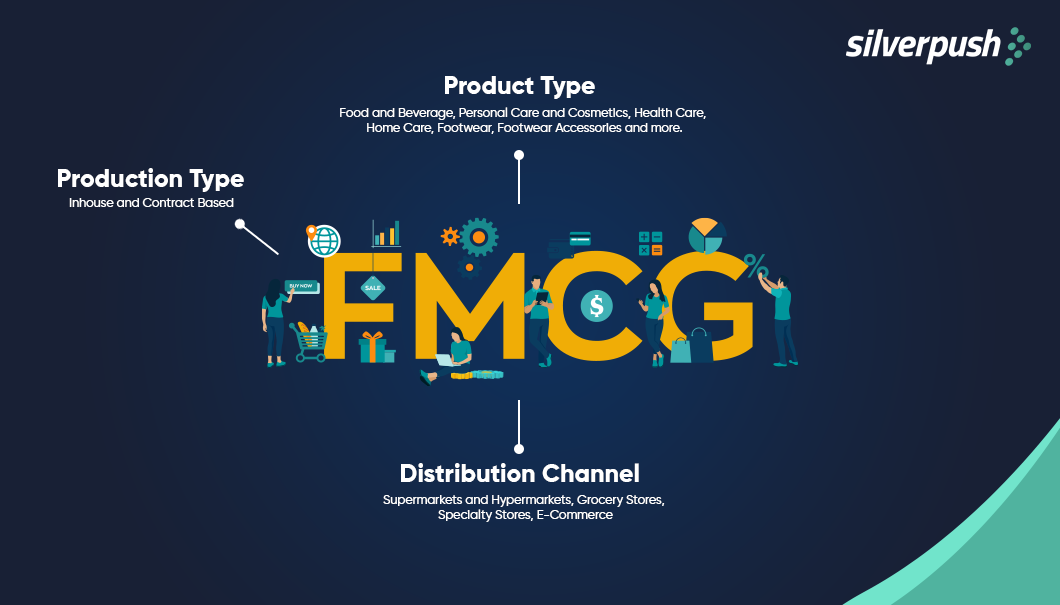
The FMCG industry is a vital component of the global economy, contributing significantly to a country’s Gross Domestic Product (GDP) and job creation. As a major driver of consumer spending, FMCG plays an essential role in various aspects of the economy.
The FMCG market size was evaluated to be 716.3 Billion in 2022 and the CAGR growth rate is expected to be 4.41% from 2023 to 2028.
The market size of the FMCG industry has significantly grown in the U.S., China, and other developed markets. Keeping the growth in mind, the experts are predicting 70% growth on a global scale. The World Bank predicts that in terms of consumer market the FMCG market in India will take the third place surpassing Japan and Germany by 2030.
The consumer industry is a highly competitive landscape, with brands vying for market share based on product type, production techniques, and distribution channels. However, in this fiercely contested arena, advertising is the key to success for them. But the advertisers are facing a set of challenges in the advertising landscape.
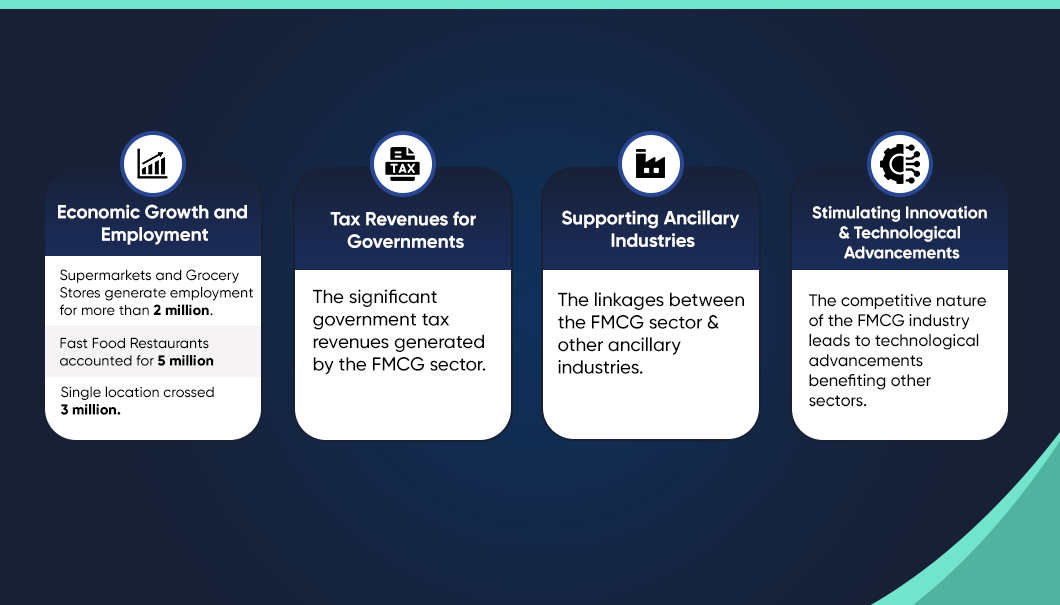
What are the Advertising Challenges Faced by the FMCG Industry?
According to a study, till 2023, FMCG firms were expected to raise their digital advertising spending by 7% yearly. FMCG expenditure decreased by 10.7% to $ 26.7 billion in 2020, a more significant decrease than the whole advertising industry.
But utilizing the ad spend is a bigger and more important factor. Since the FMCG industry is flooded with brands and products, getting brand visibility and brand recognition are the two main purposes of advertising for them. To achieve both goals choosing an appropriate advertising approach is crucial. But due to a shift in consumer behavior creating a positive and solid brand image has become difficult.
The consumer has become more empowered and they want to control everything they see, especially in the virtual space. They want to see the ads of their interest but without getting digitally stalked. 72% of people believe that virtually all of what they do online is being monitored by advertising, technology corporations, or other businesses, and 81% believe that the threats can surpass the possible rewards of data collecting.
Not only the audience but the traditional advertising ways have often led brands to face consequences of negative branding due to wrong ad placement. This not only damaged their reputation but also resulted in ad wastage.
The Rise of Contextual Advertising
Have you ever noticed that whenever you walk into a supermarket to get one item from the shelf you end up filling the cart? This is because at that moment you were interested in the items, they were relevant and you were triggered to buy them.
Contextual advertising is similar!
Through contextual targeting, advertisers reach the target audience at the right moment which triggers them to engage with the brand. According to a study, 79% of respondents agreed that they were comfortable with the ads that are relevant to them. Also, 65% said they would be more tempted to buy from relevant ads.
How can the FMCG Industry Benefit from Contextual Ads?
One approach to take advantage of the opportunity is through omnichannel contextual advertising. Silverpush’s remarkable AI-powered solution, Mirrors, ensures brand safety and suitability across various advertising channels. The high-powered AI technology ensures the message reaches the right audience.
1. YouTube
For the FMCG industry, video advertising is the most suitable ad format. YouTube offers various ad formats and advertisers can choose the most suitable format for them. According to a study, 88% of video marketers were satisfied with the ROI of their video marketing on social media.
In the past, an FMCG brand chose 1 video creative to connect and interact with the target audience. The campaign has delivered more than 9 million impressions in 28 days.
Post-campaign analysis the brand concluded that they had reached more than 5 million unique users. The campaign performed beyond the industry benchmarks as it surpassed the planned KPIs (VTR).
2. Open Web
Relevant advertising can be shown depending on the webpage content that the target audience has viewed. The mirror captures the audience’s attention, without invading the user’s privacy. This gives users a sense of safety and the advanced AI-powered technology ensures that the ad is placed in a brand-safe environment.
3. Meta
To extract contextual signals that enable the distribution of real-time, in-the-moment advertising for outstanding results, Mirrors carefully selects and examines brand-safe Facebook pages. Models for Artificial Intelligence (AI), Machine Learning (ML), and Natural Language Processing (NLP) are used to do this.
4. CTV
On most streaming TV services, CTV represents over 80% of all viewing. The remaining 20% is accounted for the other devices connected to the internet (laptops, smartphones, and tablets).
As per studies, ad spending on linear and connected TV (CTV) combined will increase from $87.24 billion to more than $100 billion in 2026. This will be due to the surge in CTV viewing.
When marketers purchase advertising space on CTV, their commercials are played to viewers when they stream movies, TV series, and other content to their linked television. To ensure brand safety, ads are delivered in the proper context with the help of semantic analysis, content analysis, and customized ad segments.
Takeaways
The advertising arena is changing rapidly and for the FMCG industry, it is their primary source of establishing brand recall. Contextual advertising can be a game-changer for them as it will help them in capitalizing on the interest of the user. It will help drive engagement without intervening with the privacy of the user. Also, omnichannel advertising can play a significant role in strengthening brand recognition.
Cricket and Advertising: Winning Strategies for the 2023 World Cup
PUBLISH DATE: 12 May 2023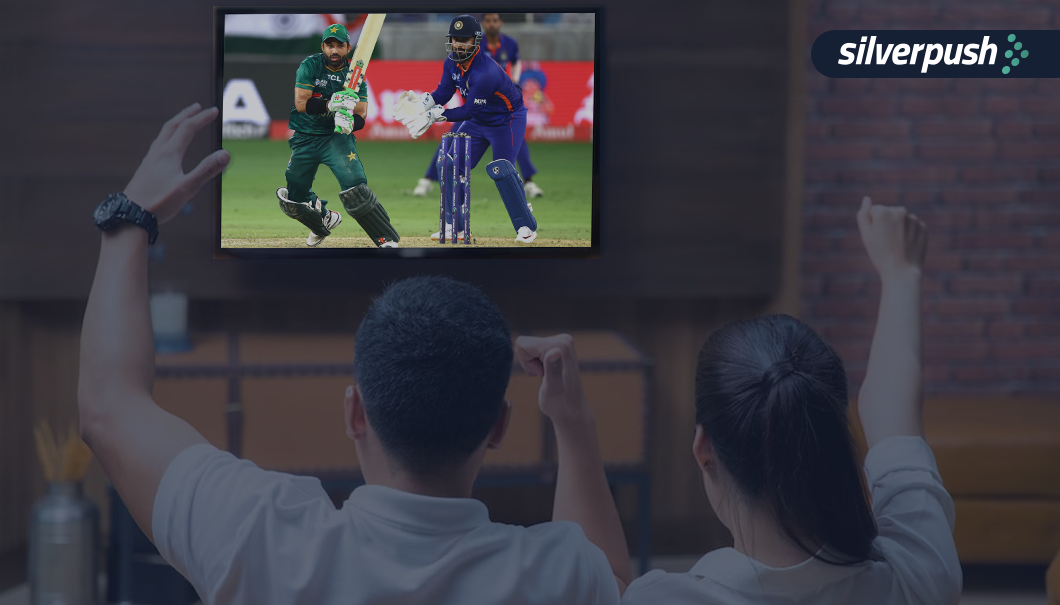
Cricket is Life. Everything else is just a game.
With 2.5 billion estimated followers, cricket is the second most popular sport around the world. The upcoming 2023, ICC Men’s Cricket World Cup has already generated excitement among fans.
The ICC Men’s Cricket World Cup isn’t a tournament that viewers enjoy; rather, it is a festival for brands to establish a rock-solid awareness. Brands have a cut-throat competition to grab the attention of the dedicated audience.
In 2019, 94% of the sports AdEx was from cricket, highlighting the popularity of the sport among advertisers. The online streaming of the matches brought a new advertising field when the World Cup was first streamed on an OTT platform in 2015. Indian advertisers alone were expected to spend more than 400 million, and Star India expected TV and internet revenues to be around Rs 2,100 crores. Along with e-commerce, gaming, soft aerated drinks category, cellular phones, wires & cables, and perfumes & deodorants were some popular categories that were on top of TV advertising. Brands paid 20 lakhs onwards for 10-second ad spots, and the sponsorship package was for 40 crores onwards.
How Brands Can Capitalize 2023 Cricket World Cup Opportunity?
The 13th 50-over ICC Men’s Cricket World Cup will take place in 2023, with India serving as the host nation. The quadrennial tournament is scheduled to take place in 2023, with India serving as the host nation for a record-breaking fourth time.
The format of the tournament will be round-robin before the knockout rounds, like the 2019 competition in England and Wales.
World Cup is the best time to tap into the audience’s mind and create a brand’s presence. Advertisers can use omnichannel advertising strategies to engage with the audience across all platforms and channels during the World Cup.
Some ways to capitalize are:
Traditional Methods Include
1. Sponsorship – Brands can become official sponsors of the tournament. A recurring brand recall can be easily created as brands will be promoted alongside the event branding.
2. Television Advertising – There is a drop in this field of advertising but millions of people are still glued to tv screens when there is a match, especially in remote areas. By creating strong tv ads brands can have the ever-lasting memory for the audience.
The “Mauka Mauka” ad campaign created a huge brand recall in 2015 and 2019 irrespective of the results. The notable point is when the first advertisement appeared on YouTube in 2015. it received more than a million organic views in the first 12 hours of being live.
Digital Methods Include
1. Video Advertising: People eagerly wait to grab any information during a cricket match. From watching a live cricket match on the OTT platform to watching highlights on YouTube, videos get the center of attention. Advertisers can leverage this attention by using different ad formats available on YouTube.
2. Social Media Advertising: During cricket tournaments, social media platforms, Instagram, Facebook, Twitter, and LinkedIn are flooded with updates. These platforms offer various advertising opportunities which an advertiser can utilize to benefit themselves. Based on the demographics, advertisers can target specific audiences.
3. CTV Advertising: A huge set of audience is shifting from traditional TV streaming to connected devices. This is an advantage for advertisers as CTV allows granular targeting. This means with the right message, advertisers can reach their target audience exactly where they are.
Another interesting advertising element present for the 2023 World Cup is contextual targeting. In 2019, the news of the phase-out of third-party cookies was spread. This led advertisers to look for an alternative. But during 2019, contextual advertising was not in the picture. However, with time this form of advertising proved to be a beneficial alternative. Combining the power of contextual advertising and the World Cup together can bring outstanding results.
Mirrors is a flagship product of Silverpush which is helping brands reach their target audience on different channels in the most contextual way possible.
How Brands Can Leverage the AI-Powered Technology, Mirrors?
Studies have proven that 63% of users prefer relevant ads and it makes them engage with the brand. This also results in higher ROIs and ROAS.
With contextual advertising, advertisers can easily engage the audience on each platform without interrupting their viewing experience.
Mirrors for YouTube
People are glued to the screen when it’s time for the World Cup. Men’s CWC 2019 live coverage crossed a cumulative average audience of 1.6 billion viewers on a global scale. The average watched time per unique viewer was 42% higher than in 2015. This leaves advertisers with the hope that it will be much higher for 2023.
To leverage the attention of the large audience of human-augmented technology, Mirrors is trained to place ads in the most relevant manner. With the help of the AI will recognize the triggers and will place the most suitable ad that aligns with the content consumed by the user.
Mirrors for Facebook
Mirrors similarly work for Facebook. But while extracting insights based on visual triggers it also dives into the context of the text.
Keyword-based targeting reduces the reach of a campaign by blocking the content based on keywords, contextual targeting understands the context of the word being used. This enhances brand safety as well as increases the ad placement opportunity.
Final Words
The World Cup is a complete package for advertisers to promote. Brands have a fantastic chance to expand their awareness and connect with a global audience during the World Cup. With the popularity of cricket at an all-time high, advertisers must take advantage of this trend and develop effective marketing campaigns that connect with their target market.
We can claim that brands could expect improved ROIs and reach during the 2023 ICC Men’s Cricket World Cup by harnessing the power of contextual advertising.
Play Safely: Strategies for Brand Safety in In-Game Advertising
PUBLISH DATE: 30 April 2023
Video games have always engaged a large audience, especially GenZ, and millennials. This gives advertisers and brands an opportunity to innovatively establish a solid brand recall.
As gaming devices continue to gain popularity and offer more opportunities for brands to reach their audience, the global gaming market is predicted to grow at a CAGR of 9.9% from 229.39 billion in 2022 to 252.10 billion in 2023. Additionally, it’s projected to reach 401.32 billion by 2027 at a CAGR of 12.3%.
The gaming industry is in an evolving phase and advertisers must explore this in-video game advertising. The primary reasons are:
- The gaming industry has a huge audience base who play games on different devices. This means brands have more than one opportunity to reach their targeted audience.
- With a large audience reach, the gaming industry has a loyal fan base. According to a study, in-gaming advertisements had influenced 44% of gamers to engage with brands.
However, this pool of advertising opportunities will require brands to focus more on brand safety.
What are the Key Components of Brand Safety for In-Video Gaming Advertising?
Measures taken to protect the brand image are known as brand safety. This is done to protect brands from irreparable damage as we had a few examples in the past of how the brand’s reputation was damaged beyond repair due to ad placement next to inappropriate content.
Interactive Advertising Bureau (IAB) has shared an impactful framework for advertisers which can help them in ensuring brand safety.
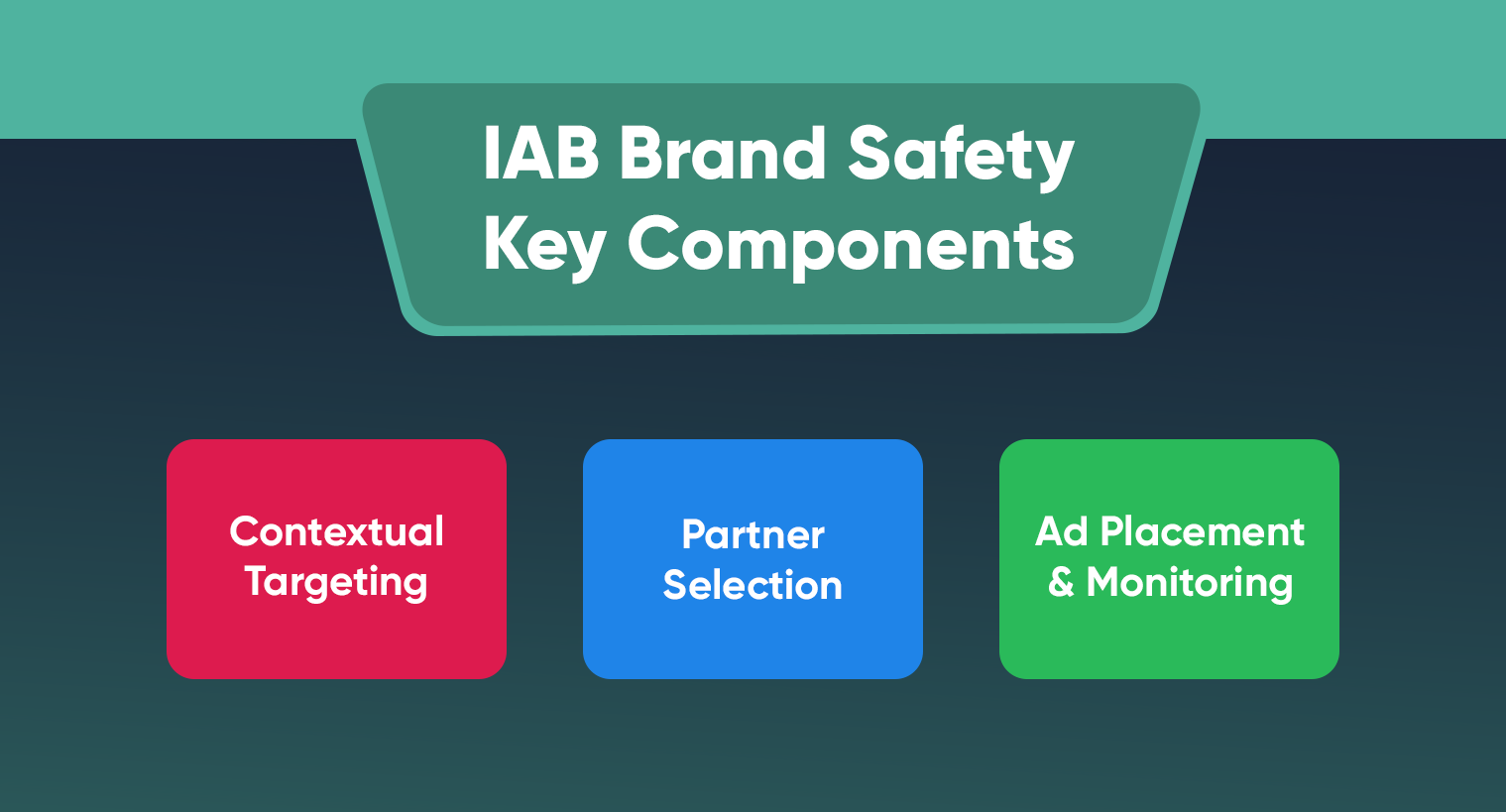
1. Contextual Targeting:
The process to phase out third-party cookies was started years ago. This was done to abide by the privacy of the user. Amidst the evolving landscape of advertising, advertisers began to rely on contextual targeting which resulted in higher brand engagement. In-video gaming advertising, advertisers must rely on contextual advertising to be profitable as the AI-powered technology ensures that the ads appear to the relevant content. A customized blocklist is prepared but unlike keyword-based targeting, the AI understands the context of the keywords used like a human mind. This increases the advertising opportunity, brand safety, and audience engagement with the brand.
2. Partner Selection:
Brands look for partners who would help them in setting up the ads in the video games. But before finalizing the partners, brands must evaluate them based on their game quality, advertising ecosystem, and compliance with General Data Protection Regulation(GDPR) and Children’s Online Privacy Protection Act (COPPA) regulations. It’s also essential to review the game’s content for any violent or inappropriate content that doesn’t align with the brand’s values. Advertisers should request a comprehensive explanation of the partner’s brand safety policies and a block list of prohibited advertisers or services.
To enhance your brand safety, you perform the following steps to ensure multi-level verification. Use a combination of the following verification tools:
- Viewability – This will help you get the percentage of ads seen by your audience. This tool ensures that your ad is seen by the target audience.
- Fraud detection-This tool will help you in identifying and preventing fraud. It will detect invalid traffic, bots, and any fraudulent activity which has the ability to impact your campaigns.
- Brand Safety Protection- This tool will add an additional layer of protection for contextual targeting. The tool will ensure that your ads aren’t displayed against inappropriate content.
- Audience Verification- This tool will give you insights into the audience who have seen your ad.
3. Ad Placement and Monitoring:
A key component of brand safety in video game advertising is ad placement. To prevent any unfavorable connotations with the brand, advertisers should make sure that their adverts are positioned in the proper areas inside the gaming environment.
For instance, advertisements for gambling or alcohol shouldn’t be included in kid-targeted games since they might expose kids to unsuitable content and harm the reputation of the company.
In a similar vein, advertisements for graphic or explicit content need to be kept out of games targeted only at adults. To make sure that their advertising is neither obtrusive nor disruptive, advertisers should also take the context of the gaming environment and the entire user experience into account.
Apart from the placement advertisers should keep a close eye on their campaigns to ensure they are not running in inappropriate places. Utilizing technology solutions and collaborating with partners to resolve any problems that may occur be part of this. For instance, advertisers may check ad placement and look for any possible brand safety issues using third-party technologies. They may also closely collaborate with their partners to resolve any problems and make any necessary modifications. In order to track success and pinpoint any areas for improvement, advertisers should also set up clear reporting tools. Advertisers that regularly report on their campaigns can better spot potential problems and take proactive steps to solve them before they become a problem.
Conclusion
The gaming industry is on the rise and in the coming years gamers will be a prominent and much larger community. Advertisers must explore this evolving landscape of advertising while they focus on brand safety.


